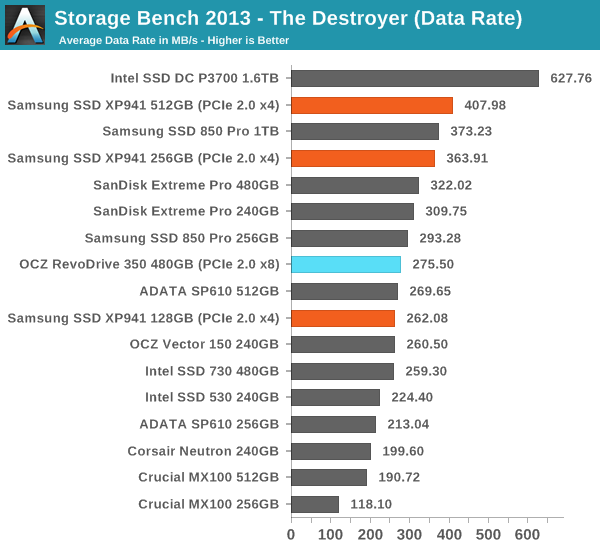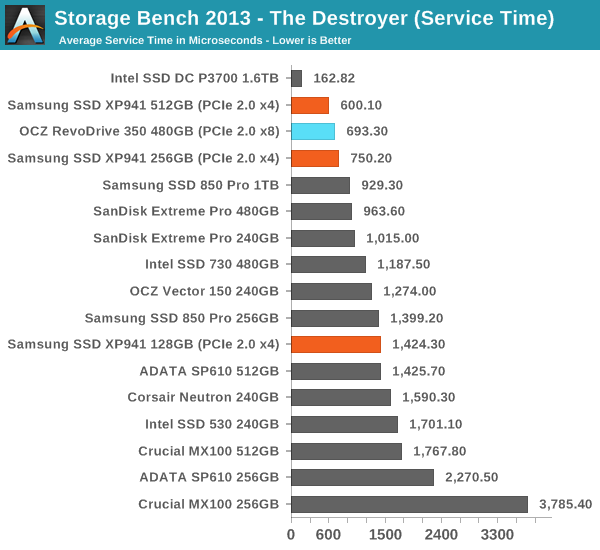PCIe SSD Faceoff: Samsung XP941 (128GB & 256GB) and OCZ RevoDrive 350 (480GB) Tested
by Kristian Vättö on September 5, 2014 3:00 PM ESTAnandTech Storage Bench 2013
Our Storage Bench 2013 focuses on worst-case multitasking and IO consistency. Similar to our earlier Storage Benches, the test is still application trace based – we record all IO requests made to a test system and play them back on the drive we are testing and run statistical analysis on the drive's responses. There are 49.8 million IO operations in total with 1583.0GB of reads and 875.6GB of writes. I'm not including the full description of the test for better readability, so make sure to read our Storage Bench 2013 introduction for the full details.
| AnandTech Storage Bench 2013 - The Destroyer | ||
| Workload | Description | Applications Used |
| Photo Sync/Editing | Import images, edit, export | Adobe Photoshop CS6, Adobe Lightroom 4, Dropbox |
| Gaming | Download/install games, play games | Steam, Deus Ex, Skyrim, Starcraft 2, BioShock Infinite |
| Virtualization | Run/manage VM, use general apps inside VM | VirtualBox |
| General Productivity | Browse the web, manage local email, copy files, encrypt/decrypt files, backup system, download content, virus/malware scan | Chrome, IE10, Outlook, Windows 8, AxCrypt, uTorrent, AdAware |
| Video Playback | Copy and watch movies | Windows 8 |
| Application Development | Compile projects, check out code, download code samples | Visual Studio 2012 |
We are reporting two primary metrics with the Destroyer: average data rate in MB/s and average service time in microseconds. The former gives you an idea of the throughput of the drive during the time that it was running the test workload. This can be a very good indication of overall performance. What average data rate doesn't do a good job of is taking into account response time of very bursty (read: high queue depth) IO. By reporting average service time we heavily weigh latency for queued IOs. You'll note that this is a metric we have been reporting in our enterprise benchmarks for a while now. With the client tests maturing, the time was right for a little convergence.

While the average data rates of the 256GB XP941 and RevoDrive are not that impressive, the average service times are. The average service time of the 256GB XP941 is nearly half of the same capacity 850 Pro and the RevoDrive too is faster than any SATA SSD, though the 512GB XP941 is still faster. The service time emphasizes high queue depth performance, which is often the stumbling stone for slower and cheaper drives, and that in turn increases their average service time.











47 Comments
View All Comments
thel33ter - Friday, September 5, 2014 - link
Excellent review as always.Personally I see the performance as being slightly disappointing, but it's just a matter of time till performance akin to the Intel P3700 is going to be within reach of the average consumer.
Probably a silly question, but would it be possible to RAID two PCIe drives?
vLsL2VnDmWjoTByaVLxb - Friday, September 5, 2014 - link
It is odd that Intel RST is kept from years ago when there are scores and scores of fixes to the drivers since the release you are using. This may dramatically impact test results.I get the desire for bench and legacy scoring, but at a certain point you have to let go of legacy when serious improvements have been made to reliability, errata, bugs, etc, from previous drivers. Not to mention nobody should be using the drivers from this review.
Kristian Vättö - Friday, September 5, 2014 - link
We are in the process of upgrading to a new testbed with the latest drivers, but we stumbled into some incompatibilities that have delayed the transition.Remember that storage drivers are not as important as e.g. GPU drivers where one version can have dramatic improvements to one game. After all, the RST drivers are the same for all drives, so driver improvements should affect all drives pretty much equally.
joannecdinkins - Friday, September 5, 2014 - link
just as Larry answered I didnt even know that people able to get paid $6104 in a few weeks on the internet .go to this site>>>>> paygazette.ℭOM
coburn_c - Friday, September 5, 2014 - link
512GB occupying a desktop pcie slot is still criminal. Works well for mobile devices but we need to get these prices down and these capacities up in the desktop space.Kristian Vättö - Saturday, September 6, 2014 - link
Quite a few of the newer boards already come with M.2 slots, so if you are shopping for a new system you might as well choose a board that has a proper PCIe x4 M.2 slot.Galatian - Saturday, September 6, 2014 - link
But that limits your choice to essentially Intel Z97 or X99 chipset and from my research on Z97 this actually only leaves the ASRock Extreme6 and 9 as well as the mITX ASUS Maximus Impact VII.KarlKaiser - Friday, September 5, 2014 - link
Thanks for this article. It is obvious the storage industry is about to change but what I miss as an end-user is helpful comparisons from journalists like yourself that might help me to figure out what to buy now/soon. Keep it up!For example, for another $100 more than the 512GB Samsung XP941, soon we'll get the 400GB Intel DC P3500, which is on paper twice as fast at W/R 2500/1700 MB/s, if a somewhat smaller capacity.
Kristian Vättö - Saturday, September 6, 2014 - link
The P3500 is something I'll definitely be reviewing (for both, enterprise and client since there's been a ton of interest), but unfortunately we don't have any samples.DMCalloway - Saturday, September 6, 2014 - link
I agree. The Intel DC P series is the one to watch right now.